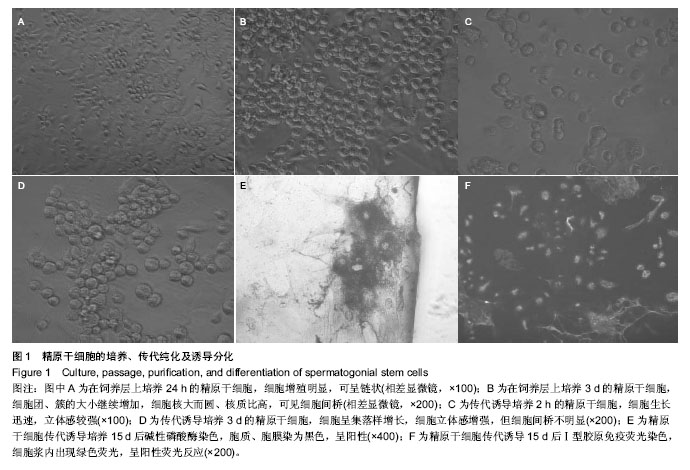| [1] Thomson JA,Itskovitz- Eldor J,Shapiro SS,et al.Embryonic stem cell lines deribed from human blastocyts.Science. 1998;282(5391):1145-1147.
[2] Sumner JP, Shapiro EM, Maric D,et al.In vivo labeling of adult neural progenitors for MRI with micron sized particles of iron oxide: quantification of labeled cell phenotype.Neuroimage. 2009;44(3):671-678.
[3] Vande Velde G, Raman Rangarajan J, Vreys R, et al. Quantitative evaluation of MRI-based tracking of ferritin-labeled endogenous neur cell progeny in rodent brain.Neuroimage. 2012; 62(1):367-380.
[4] Boulland JL, Leung DS, Thuen M,et al.Evaluation of intracellular labeling with micron-sized particles of iron oxide (MPIOs) as a general tool for in vitro and in vivo tracking of human stem and progenitor cells.Cell Transplant. 2012; 21(8):1743-1759.
[5] Chikhovskaya JV, Jonker MJ, Meissner A, et al.Human testis-derived embryonic stem cell-like cells are not pluripotent, but possess potential of mesenchymal progenitors. Hum Reprod. 2012;27(1):210-221.
[6] Moraveji SF, Attari F, Shahverdi A,et al.Inhibition of glycogen synthase kinase-3 promotes efficient derivation of pluripotent stem cells from neonatal mouse testis. Hum Reprod. 2012; 27(8):2312-2324.
[7] Kanda A, Sotomaru Y, Shiozawa S,et al.Establishment of ES cells from inbred strain mice by dual inhibition (2i).J Reprod Dev. 2012;58(1):77-83.
[8] 胡智兴,耿菊敏,梁道明.肝细胞生长因子促进人胚胎干细胞向神经前体细胞分化[J].中国病理生理杂志,2010,26(4): 730-736.
[9] 李英博,王莎莉.体外诱导人胚胎干细胞向神经细胞分化的研究进展[J].神经解剖学杂志,2004,20(6):633-636.
[10] 田寿福,郭烨,牛鑫,等.细胞生长因子联合诱导ES细胞向肾脏前体细胞分化的实验研究[J].中国中西医结合肾病杂志,2012, 13(12):1058-1061.
[11] 马良宏,丁强,冯立新.精原干细胞冷冻保存后再移植的生精功能[J].中国组织工程研究与临床康复,2010,14(31):5767-5772.
[12] De Beur SM, Finnegan RB, Vassiliadis J,et al.Tumors associated with oncogenic osteomalacia express genes important in bone and mineral metabolism.J Bone Miner Res. 2002;17(6):1102-1110.
[13] Imanishi Y, Hashimoto J, Ando W,et al. Matrix extracellular phosphoglycoprotein is expressed in causative tumors of oncogenic osteomalacia.J Bone Miner Metab. 2012;30(1): 93-99.
[14] 杨春露,赵勇,陈建庭.骨髓基质细胞-成骨细胞复合培养体系的建立[J].中国组织工程研究,2013,17(6):980-984.
[15] Bing Z, Linlin L, Jianguo Y, et al. Effect of mechanical stretch on the expressions of elastin, LOX and Fibulin-5 in rat BMSCs with ligament fibroblasts co-culture. Mol Biol Rep. 2012;39(5): 6077-6085.
[16] Qing C,Wei-ding C,Wei-min F.Co-culture of chondrocytes and bone marrow mesenchymal stem cells in vitro enhances the expression of cartilaginous extracellular matrix components.Braz J Med Biol Res. 2011;44(4):303-310.
[17] Bellaiche J,Lareyre JJ,Cauty C,et al.Spermatogonial Stem Cell Quest: nanos2, Marker of a Subpopulation of Undifferentiated A Spermatogonia in Trout Testis. Biol Reprod. 2014.[Epub ahead of print]
[18] Eslahi N, Hadjighassem MR.The effects of poly L-lactic acid nanofiber scaffold on mouse spermatogonial stem cell culture.Int J Nanomedicine. 2013;8:4563-4576.
[19] Rastegar T, Minaee MB, Habibi Roudkenar M,et al.Improvement of Expression of α6 and β1 Integrins by the Co-culture of Adult Mouse Spermatogonial Stem Cells with SIM Mouse Embryonic Fibroblast Cells (STO) and Growth Factors.Iran J Basic Med Sci. 2013;16(2):134-139.
[20] Gassei K,Orwig KE.SALL4 expression in gonocytes and spermatogonial clones of postnatal mouse testes. PLoS One. 2013;8(1):e53976.
[21] Hermann BP, Sukhwani M, Simorangkir DR,et al.Molecular dissection of the male germ cell lineage identifies putative spermatogonial stem cells in rhesus macaques. Hum Reprod. 2009;24(7):1704-1716.
[22] Lee YA, Kim YH, Ha SJ, et al.Effect of sugar molecules on the cryopreservation of mouse spermatogonial stem cells.Fertil Steril. 2014;101(4):1165-1175.
[23] Tiptanavattana N, Thongkittidilok C,Techakumphu M,et al.Characterization and in vitro culture of putative spermatogonial stem cells derived from feline testicular tissue.J Reprod Dev. 2013;59(2):189-195.
[24] Yang QE,Oatley JM.Spermatogonial stem cell functions in physiological and pathological conditions.Curr Top Dev Biol. 2014;107:235-267.
[25] 徐富翠,吴绍华,郭勇,等.精原干细胞体外非分化扩增的初步研究[J].四川大学学报医学版,2006,37(4):625-628.
[26] Chaudhary LR, Hofmeister AM, Hruska KA, et al. Differential growth factor control of bone formation through osteoprogenitor differentiation. Bone. 2004;34(3):402-411.
[27] Tiptanavattana N,Thongkittidilok C,Techakumphu M,et al.Characterization and in vitro culture of putative spermatogonial stem cells derived from feline testicular tissue.J Reprod Dev. 2013;59(2):189-195.
[28] 张光东,徐艳,吴友农,等.碱性成纤维细胞生长因子和胰岛素样生长因子-1对人牙髓细胞碱性磷酸酶活性及矿化能力的影响[J].口腔医学,2006,26(4):261-263.
[29] 邬波,马旭,朱大木,等.胰岛素样生长因子1对骨髓间充质干细胞软骨分化及基质金属蛋白酶表达的影响[J].中国组织工程研究, 2013,17(19):3421-3429.
[30] 包敏,张德平.胰岛素样生长因子1作用下的骨髓间充质干细胞对大鼠肺纤维化的治疗作用及其机制[J].中国呼吸与危重监护杂志, 2011,10(1):42-49. |

.jpg)